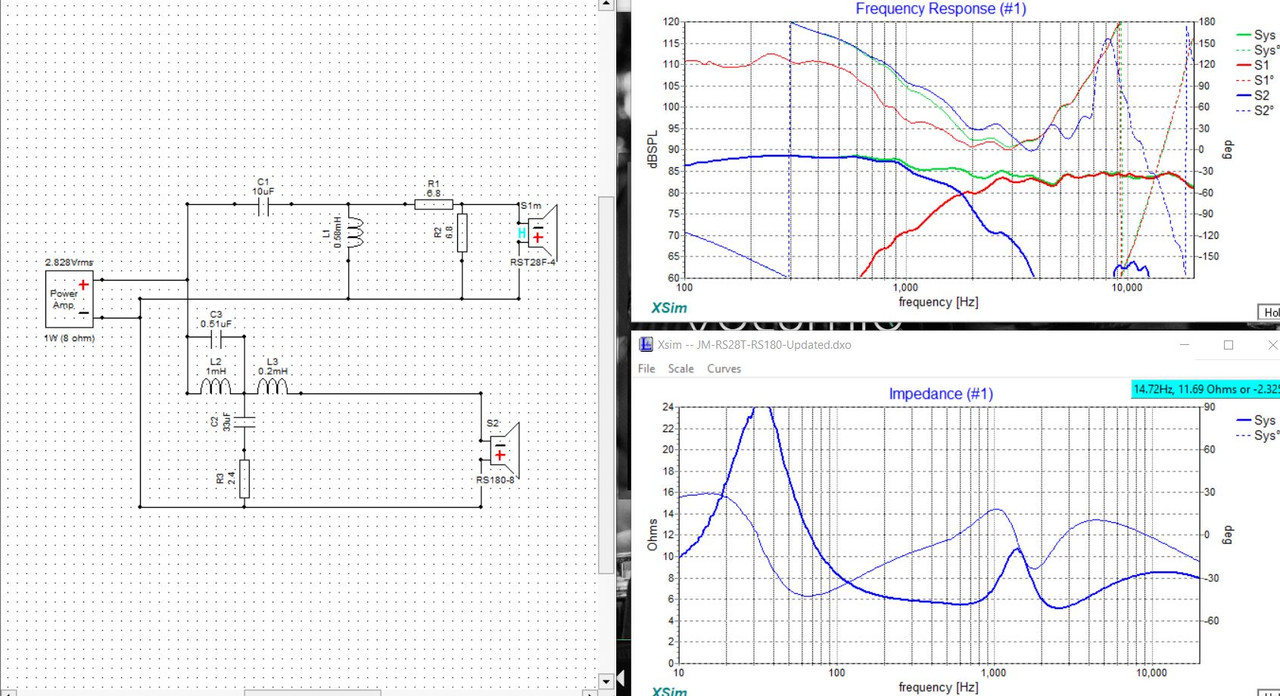I still hear a lot of ringing and some sort of metallic sound do i need to redo the crossover from scratch?Yes.
This doesn't matter. Left and right should be the same.
I think its the tweeter but can be heard overallWhich driver is it coming from or is it from the combination?
No just covering each driver, i think the paino, guitar and cymbals etc sounds ringing/metallicYou tested this by disconnecting each driver?
I am.coming from dc28f to rst28f both are silk dome but to me rst sounds harsh
You might have a hole in the response. The tweeter stands out when it has no woofer joining its response. Did you try inverting the polarity?
It has been my experience using a Morel tweeter with just a single resistor in series that exhibited the same "Ringing" a simple fix was to add another resistor of approximately 22Ohms 5Watt in parallel. Sending the "Harsh" resident noise to ground! Here you will see a link to the image that describes the network. Apologies if someone has submitted this fix prior. How To Reduce Tweeter Volume - Everything You Need To Know! Another avenue to consider is placing damping material on the woofer basket supports. The ringing may be your woofer basket/frame transmitting the resonant sound through your woofer cone. Not the cone itself, but the woofer frame.
Kingfisher
Kingfisher
You might have a hole in the response. The tweeter stands out when it has no woofer joining its response. Did you try inverting the polarity?
I have tried all the combination of polarity. this is how it stands now

It has been my experience using a Morel tweeter with just a single resistor in series that exhibited the same "Ringing" a simple fix was to add another resistor of approximately 22Ohms 5Watt in parallel. Sending the "Harsh" resident noise to ground! Here you will see a link to the image that describes the network. Apologies if someone has submitted this fix prior. How To Reduce Tweeter Volume - Everything You Need To Know! Another avenue to consider is placing damping material on the woofer basket supports. The ringing may be your woofer basket/frame transmitting the resonant sound through your woofer cone. Not the cone itself, but the woofer frame.
Kingfisher
I already have the LPAD to reduce tweeter, if I go further low then its way low
Your F R graph does not bare out what you describe subjectivity. My guess would be that either your original F R or impedance measurements are inaccurate or the tweeter is stuggling with a Xover frequency that is too low, particularly if you listen at a healthy volume. If you're happy the measurements are accurate I suggest raising the Xover frequency, otherwise I would remeasure then reassess.
Very unlikely unless they have both been over driven. I've heard tweeters after overdriving and they sound EXTREMELY metallic where the voice coil has separated from the dome and both vibrate loosely. Think of two hard surfaces vibrating against each other at high frequency for an idea of the sound.
These are manufacturer frd and zmaYour F R graph does not bare out what you describe subjectivity. My guess would be that either your original F R or impedance measurements are inaccurate or the tweeter is stuggling with a Xover frequency that is too low, particularly if you listen at a healthy volume. If you're happy the measurements are accurate I suggest raising the Xover frequency, otherwise I would remeasure then reassess.
In that case they are almost meaningless as they will not have taken account of the baffle step effect on your baffle. This is a big issue! You will therefore need to adjust tweeter level by ear and ignore the graph unless you can measure the actual FR and impedance of the drivers mounted on your baffle, then design the Xover using those.
Last edited:
'I already have the LPAD to reduce tweeter, if I go further low then its way low" The 22 Ohm resistor is in the parallel location. If you were to balance the output of tweeter to match the woofer you would use maybe a 3.1 Ohm - 5.6 Ohm in series the 22Ohm is in "Shunt" position.
With dbx2344xs, when I set the crossover at 1400hz it sounds better to me. Does this mean with earlier crossover the woofer was getting high frequency which was sounding metallic?
When guessing at a crossover there are many things that can happen. Sometimes, you create one problem and it takes away another. Therefore it takes a little time to come to learn what makes sense and what doesn't.
Big learning curve it seems so, with same drivers some have crossed at 1400 and 1800 and 2000 so will try to catch what they are doing with it. Omini mic is on the way so I can measure it next week 🙂
- Home
- Loudspeakers
- Multi-Way
- Introduction to designing crossovers without measurement